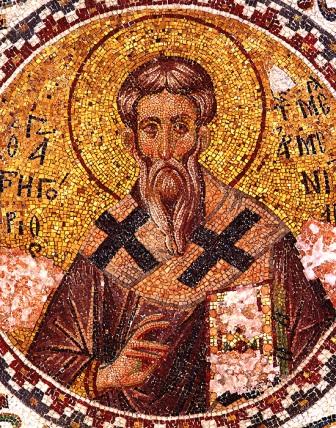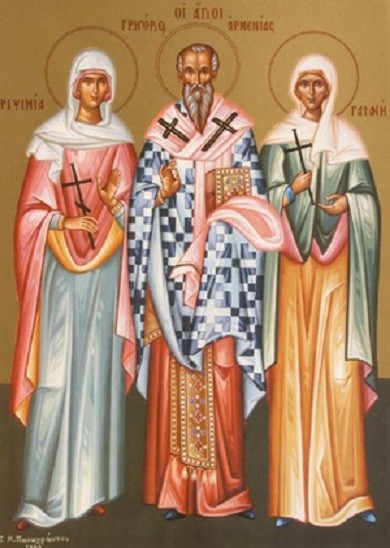|
|
St Gregory the Enlightener, Bishop of Armenia Gregory was of a noble family, kin to the imperial house of Persia (to King Artaban) and Armenia (King Khosrov). When these two houses made war between themselves, Gregory withdrew to Caesarea in Cappadocia, where he first came into contact with the Christian faith, received baptism and married. He had two sons of this marriage, Rostanes and Aristanes, and dedicated them both to the service of the Church. After his wife"s death, he returned to Armenia and entered the service of King Tiridates. Gregory served his king faithfully, and the king loved him, but, when he discovered that Gregory was a Christian, he was greatly enraged and put pressure on him to reject the Christian faith and worship idols. Having no success whatever in this, Tiridates put Gregory to harsh torture and, after cruel torment, threw him into a deep pit filled with every kind of poisonous reptile, meaning thus to kill him. But God, who is all-seeing, preserved Gregory alive in that pit for fourteen whole years. Tiridates continued the persecution of Christians in his kingdom, and attacked a women"s monastery of thirty-seven nuns with their abbess, Gaiane. When he had slain them with terrible tortures, Tiridates went mad and was like a monstrous wild boar. A man appeared to the king"s sister in a dream and told her that her mad brother would not be restored to sanity until Gregory was taken out of the pit. This being done, Gregory healed and baptised Tiridates. Then Gregory, at the king"s desire, became Bishop of Armenia and, with the king"s help and, above all, God"s help, enlightened the whole of Armenia and the surrounding area with the Christian faith. St Gregory finished his life of great toil in old age, in about 335. In his place, his son Aristanes was consecrated bishop, and he continued his father"s work. Aristanes was one of the 318 fathers at the First Ecumenical Council. Gregory was of a noble family, kin to the imperial house of Persia (to King Artaban) and Armenia (King Khosrov). When these two houses made war between themselves, Gregory withdrew to Caesarea in Cappadocia, where he first came into contact with the Christian faith, received baptism and married. He had two sons of this marriage, Rostanes and Aristanes, and dedicated them both to the service of the Church. After his wife"s death, he returned to Armenia and entered the service of King Tiridates. Gregory served his king faithfully, and the king loved him, but, when he discovered that Gregory was a Christian, he was greatly enraged and put pressure on him to reject the Christian faith and worship idols. Having no success whatever in this, Tiridates put Gregory to harsh torture and, after cruel torment, threw him into a deep pit filled with every kind of poisonous reptile, meaning thus to kill him. But God, who is all-seeing, preserved Gregory alive in that pit for fourteen whole years. Tiridates continued the persecution of Christians in his kingdom, and attacked a women"s monastery of thirty-seven nuns with their abbess, Gaiane. When he had slain them with terrible tortures, Tiridates went mad and was like a monstrous wild boar. A man appeared to the king"s sister in a dream and told her that her mad brother would not be restored to sanity until Gregory was taken out of the pit. This being done, Gregory healed and baptised Tiridates. Then Gregory, at the king"s desire, became Bishop of Armenia and, with the king"s help and, above all, God"s help, enlightened the whole of Armenia and the surrounding area with the Christian faith. St Gregory finished his life of great toil in old age, in about 335. In his place, his son Aristanes was consecrated bishop, and he continued his father"s work. Aristanes was one of the 318 fathers at the First Ecumenical Council.The Holy Martyrs Gaiane, Rhipsimia and 35 other nuns They were all slain by Tiridates for their faith in Christ. Holy Rhipsimia was of rare beauty, and the Emperor Diocletian therefore wanted her-for his wife. This-was the cause of the suffering of all thirty-seven of them. Rhipsimia refused to go to the Emperor, because she was already consecrated to Christ her bridegroom. Then Tiridates began to urge her to go with him, for the king was as though intoxicated by her beauty, but Rhipsimia resisted the pagan king with all her strength, "and he who was victorious over the princes of the Goths and routed the Persians could not overcome one virgin of Christ". The furious king put her to harsh torture (her tongue was cut out, her stomach cut open and her entrails spilled out), during which Rhipsimia gave her soul into God"s hands. After that, the other nuns were seized and beheaded with the sword. The famous monastery of Echmiazdin, near Erivan. was built over their relics, and became the chief spiritual centre of Armenia for many centuries. They were all slain by Tiridates for their faith in Christ. Holy Rhipsimia was of rare beauty, and the Emperor Diocletian therefore wanted her-for his wife. This-was the cause of the suffering of all thirty-seven of them. Rhipsimia refused to go to the Emperor, because she was already consecrated to Christ her bridegroom. Then Tiridates began to urge her to go with him, for the king was as though intoxicated by her beauty, but Rhipsimia resisted the pagan king with all her strength, "and he who was victorious over the princes of the Goths and routed the Persians could not overcome one virgin of Christ". The furious king put her to harsh torture (her tongue was cut out, her stomach cut open and her entrails spilled out), during which Rhipsimia gave her soul into God"s hands. After that, the other nuns were seized and beheaded with the sword. The famous monastery of Echmiazdin, near Erivan. was built over their relics, and became the chief spiritual centre of Armenia for many centuries.St Michael, First Metropolitan of Kiev He was sent by the Patriarch of Constantinople to Russia at the request of the great Prince Vladimir, to baptise the pagan people and to establish and organise the Church. St Michael baptised the people in Kiev. Novgorod, Rostov and many other towns and villages, set the Church in order, establishing the episcopate and priesthood, laid the foundations of the monastery of St Michael in Kiev, and sent missionaries to the Bulgars and Tartars, bringing many of them to Christ. This saint accomplished all this and much else in a mere four years. He entered peacefully into rest in 992, and his relics are preserved in the Monastery of the Caves. He was sent by the Patriarch of Constantinople to Russia at the request of the great Prince Vladimir, to baptise the pagan people and to establish and organise the Church. St Michael baptised the people in Kiev. Novgorod, Rostov and many other towns and villages, set the Church in order, establishing the episcopate and priesthood, laid the foundations of the monastery of St Michael in Kiev, and sent missionaries to the Bulgars and Tartars, bringing many of them to Christ. This saint accomplished all this and much else in a mere four years. He entered peacefully into rest in 992, and his relics are preserved in the Monastery of the Caves.Martyr Stratonicus
Martyr Mardonius
|